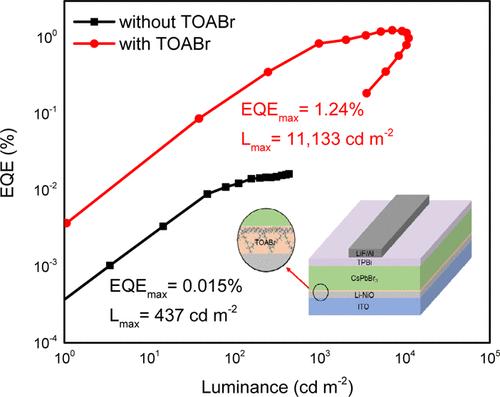Tetraoctylammonium Bromide Interlayer between NiLiOx and Perovskite for Light-Emitting Diodes
IF 8.3
2区 材料科学
Q1 MATERIALS SCIENCE, MULTIDISCIPLINARY
引用次数: 0
Abstract
Physical vapor deposition is a favorable technique for fabricating light-emitting diodes (LEDs) due to its scalability and reproducibility. However, the performances of LEDs fabricated via this method are worse than those prepared via solution processing owing to the generation of high defect densities. In this study, we introduce a layer of tetraoctylammonium bromide (TOABr), an interfacial-modification compound containing four long octyl chains that are symmetrically arranged around an N atom, to reduce nonradiative recombination and trap densities in CsPbBr3. We examined the impacts of adding TOABr on perovskite thin films deposited on hole injection layers made of Li-doped NiOx and poly(3,4-ethylenedioxythiophene)/polystyrenesulfonate. Our investigations reveal that TOABr addition slightly increases crystallinity, dramatically increases photoluminescence, and achieves the preferred orientation in the perovskite films. Additionally, the interfacial layer passivates defects and improves charge balance in the device, thereby enhancing performance. Consequently, perovskite LEDs with a TOABr layer exhibit a lower turn-on voltage of 3 V than their pristine counterparts, achieving a maximum luminance of 11,133 cd m–2 and an external quantum efficiency of 1.24%, whereas the pristine perovskite LEDs achieve an EQE of 0.015%. The approach proposed in this study can be used to fabricate efficient vacuum-thermal-evaporated perovskite LEDs.

用于发光二极管的 NiLiOx 和 Perovskite 之间的四辛基溴化铵夹层
物理气相沉积具有可扩展性和可重复性,是制造发光二极管(LED)的有利技术。然而,由于会产生较高的缺陷密度,通过这种方法制造的发光二极管的性能要比通过溶液加工制备的发光二极管差。在本研究中,我们引入了一层四辛基溴化铵(TOABr),这是一种界面修饰化合物,含有四条围绕一个 N 原子对称排列的长辛基链,可降低 CsPbBr3 中的非辐射重组和陷阱密度。我们研究了添加 TOABr 对沉积在掺锂 NiOx 和聚(3,4-亚乙二氧基噻吩)/聚苯乙烯磺酸盐空穴注入层上的包晶体薄膜的影响。我们的研究发现,TOABr 的加入会略微增加结晶度,显著提高光致发光,并使过氧化物薄膜达到优选取向。此外,界面层还能钝化缺陷,改善器件中的电荷平衡,从而提高性能。因此,带有 TOABr 层的透辉石 LED 的开启电压为 3 V,低于原始 LED,最大亮度达到 11,133 cd m-2,外部量子效率为 1.24%,而原始透辉石 LED 的 EQE 为 0.015%。本研究提出的方法可用于制造高效的真空-热蒸发过氧化物发光二极管。
本文章由计算机程序翻译,如有差异,请以英文原文为准。
求助全文
约1分钟内获得全文
求助全文
来源期刊

ACS Applied Materials & Interfaces
工程技术-材料科学:综合
CiteScore
16.00
自引率
6.30%
发文量
4978
审稿时长
1.8 months
期刊介绍:
ACS Applied Materials & Interfaces is a leading interdisciplinary journal that brings together chemists, engineers, physicists, and biologists to explore the development and utilization of newly-discovered materials and interfacial processes for specific applications. Our journal has experienced remarkable growth since its establishment in 2009, both in terms of the number of articles published and the impact of the research showcased. We are proud to foster a truly global community, with the majority of published articles originating from outside the United States, reflecting the rapid growth of applied research worldwide.
 求助内容:
求助内容: 应助结果提醒方式:
应助结果提醒方式:


